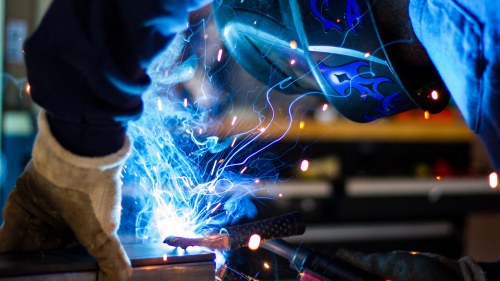Midwestern Manufacturing Survives and Thrives

The Midwest has faced a decline in manufacturing for decades, but if states in the region work together, it can remain a vital part of the regional economy.
Everybody knows the problems with Midwestern manufacturing— the shift to the Sun Belt, followed by outsourcing and now, the technology revolution. These woes don’t need detailing because, when we think of manufacturing in the Heartland, it’s what comes immediately to mind.
Which is why it’s useful to remind ourselves that manufacturing in much of the Midwest is alive, well and growing. The fact is that the old industrial belt both produces and exports more manufactured goods than it ever did.
This doesn’t mean that manufacturing will ever again generate the mass employment that it did in the bygone days of assembly lines and blast furnaces. It still accounts for a lot of good jobs but will never again be the basis of a middle-class economy, as it was in Chicago and so many other Midwestern cities in the post-World War II years.
Manufacturing, in fact, looks a lot today like farming. Once upon a time, agriculture underpinned the Midwestern economy and employed half or more of all Midwesterners. Farming is still vital to the region’s economy: the income, especially from food exports, is huge. But the industry employs barely two percent of the region’s population.
Ditto for manufacturing. Over the years, Midwesterners emigrated from farms to the factory jobs of the cities. Industry employed 35 or 40 percent of all Midwesterners. It’s still vital to our economy, especially in the exports it sends to the world. But it employs only nine percent of Midwestern workers, a figure that has been falling for years.
Much of this was the gist of a paper called “Revival in the Heartland: Manufacturing and Trade in Chicago,” which I wrote the HSBC, the international banking group which has sponsored a series of papers around the country on the role that trade plays in the American economy. With the help of Phil Levy, a colleague and senior fellow at The Chicago Council, I argued that manufacturing is still crucial to our regional economy and deserves all the help it can get.
But important as it is, “manufacturing in Chicago is an old heavyweight slugger, punching below its weight,” the paper said. It produces and exports a lot but could produce and export much more. The report focused on Chicago, but the same holds true for manufacturing across the Midwest.
The paper reported that manufacturing accounts for $53.9 billion of the Chicago region’s gross product, making it the second leading industry (after social services). Illinois exported $63.2 billion in 2012— the figure undoubtedly is higher now— and manufactured goods account for 90 percent of those exports.
Manufacturing jobs pay $6.4 billion total to Chicago-region workers. These are both high-skilled jobs in factories and logistics and, increasingly, very high-wage jobs in business services— law, accounting, consulting, and the like. Chicago is a global center of manufacturing expertise, and these services export their knowledge to the rest of the world.
But the report and a front-page article about it in the Chicago Tribune, stressed that the region could do better.
One problem is the litany of reports from academia and the media on the decline of manufacturing jobs. These reports gave the impression that manufacturing was dying, leading policymakers to put support for manufacturing on the back burner and to focus attention on other more likely sources of jobs.
Another is the lack of cooperation between Midwestern states, all of whom rose together on the manufacturing boom of the industrial age and declined together when the end of that age cut into factory employment. All these states share an interest in promoting Midwestern manufacturing, but they spend most of their time instead trying to steal businesses from each other.
A key example is the lack of cooperation between Midwestern states on the single most important factor in their export prowess, which is the state of transport and logistics through Chicago. Throughout its history, the city’s location has made it a crossroads for trade, starting with overland convoys from the East and building over the centuries, as it became a center for highways, trains, and planes. The condition of this hub is crucial for all Midwestern states and their exporters.
Yet very little has been done to untangle the snarl of rail lines and highways that bring so much transcontinental freight traffic to a crawl as it crosses Chicago. A recent report by the Organization for Economic Cooperation and Development (OECD) noted that Illinois and the surrounding states do little to coordinate train traffic through Chicago, to their mutual harm.
There are signs, though, that manufacturing is getting the public attention it needs.
First is the boom in shale oil and natural gas, much of it produced in the Midwest, slashing energy costs for manufacturers. Second is the reshoring of some industry from overseas: much of this manufacturing is highly automated, though, so it’s expanding the capacity of industry without creating many jobs.
Third is the new emphasis on so-called advanced industry. Too often, this is equated with space-age products such as smart phones that do more for output in Silicon Valley than in the Midwest. But Midwestern experts note that advanced industry has more to do with processes than products: the Midwest still makes many of the same old products, such as steel and earthmovers, but does it with highly advanced techniques and processes that make the region a center for advanced industry.
The federal government’s decision to locate three of its advanced industrial laboratories in Chicago, Detroit and Youngstown embraces this new thinking.
The laboratories will also underline the most important thing about manufacturing— its ability to spur innovation. From the steam engine to 3-D printing, most of the important innovations in the modern economy have spun off manufacturing. That won’t stop. To the degree that the Midwest keeps its manufacturing base strong, it still has an economic future.

